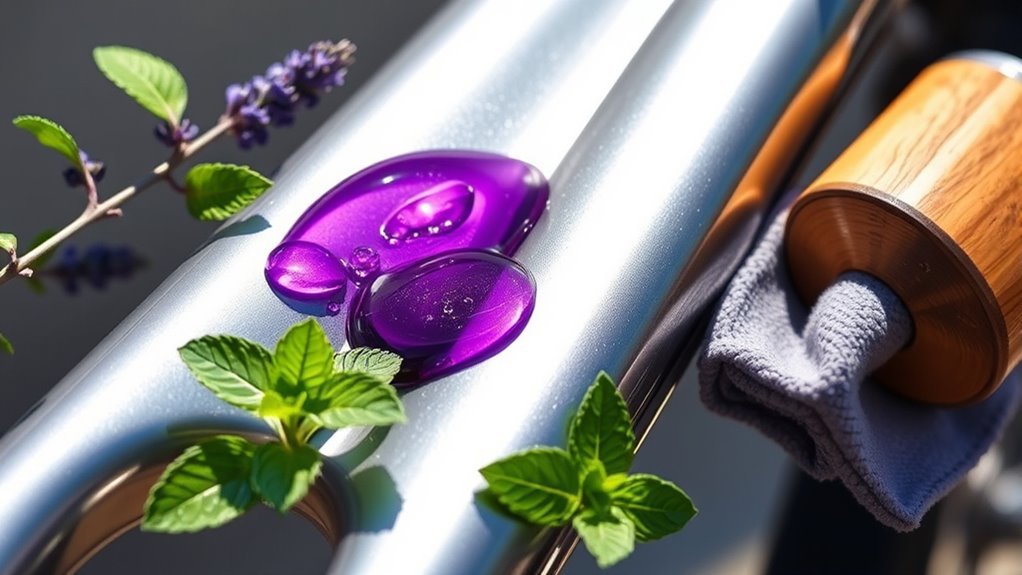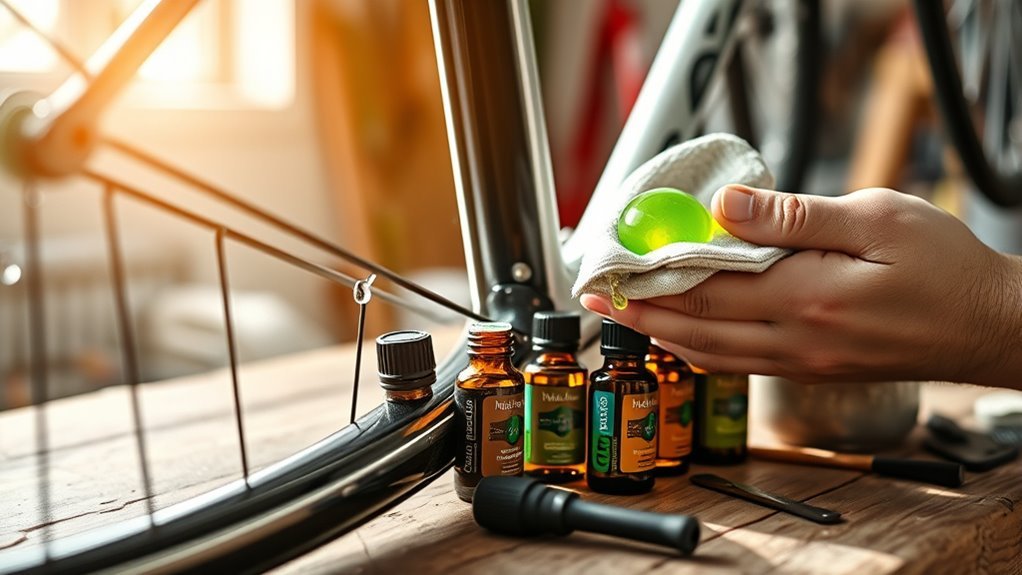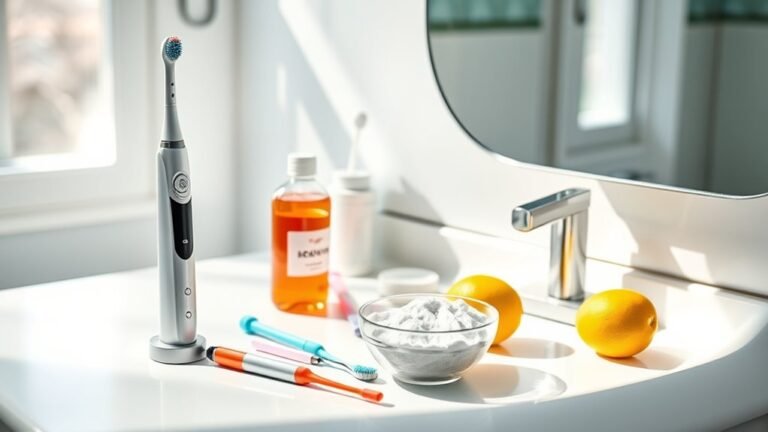Using Essential Oils to Clean Bike
You can clean your bike effectively using essential oils like lemon, tea tree, or eucalyptus, which offer natural antimicrobial and degreasing properties. Dilute a few drops in water or mild soap to avoid surface damage, then apply carefully. These oils help remove grime while minimizing chemical residue and environmental impact. Always test solutions on small areas and rinse thoroughly to protect your bike’s finish. Exploring proper preparation and safety guarantees ideal results and maintenance.
Benefits of Using Essential Oils for Bike Cleaning

Although traditional cleaning agents are effective, using essential oils for bike cleaning offers distinct advantages due to their natural antimicrobial properties and ability to break down grime without harsh chemicals. When you choose essential oils, you employ a natural disinfectant that reduces reliance on synthetic substances, promoting environmental freedom and personal health. Additionally, these oils provide an aromatic experience, enhancing the cleaning process with subtle, natural scents that conventional cleaners lack. This method minimizes exposure to potentially harmful residues while maintaining efficacy against bacteria and dirt. However, it’s important to apply essential oils with precision, as their potency varies and misuse could damage bike surfaces. By integrating essential oils thoughtfully, you can achieve a balanced, effective cleaning routine that respects both your bike’s integrity and your desire for chemical-free freedom.
Essential Oils With the Best Cleaning Properties
Several essential oils have demonstrated strong cleaning properties suitable for bike maintenance, thanks to their antimicrobial and solvent capabilities. You’ll find that certain oils effectively break down grime while inhibiting microbial growth, ensuring a cleaner, invigorating bike.
| Essential Oil | Cleaning Properties |
|---|---|
| Tea Tree | Antimicrobial, antifungal |
| Lemon | Degreasing, solvent for oils |
| Eucalyptus | Antibacterial, deodorizing |
| Peppermint | Antimicrobial, invigorating scent |
| Lavender | Antiseptic, mild solvent |
Choosing the right essential oils balances cleaning efficiency and safety for your bike’s materials. Use them thoughtfully to maintain freedom in your bike care routine while ensuring ideal cleanliness.
How to Prepare Essential Oil Cleaning Solutions

When preparing essential oil cleaning solutions for your bike, you’ll need to carefully select oils known for their antimicrobial and degreasing properties. It’s important to mix these oils with appropriate carrier liquids, such as water or vinegar, in precise ratios to guarantee effectiveness and safety. Always test your solution on a small bike surface area to avoid potential damage before full application.
Selecting Essential Oils
Because different essential oils possess varying antimicrobial and solvent properties, choosing the right ones is crucial for effective bike cleaning solutions. You’ll want to evaluate oils with strong aromatic properties that also serve as natural solvents or disinfectants. Combining these oils into balanced oil blends can enhance cleaning efficiency while preserving your bike’s surfaces. Use the table below to guide your selection:
| Essential Oil | Key Property | Recommended Use |
|---|---|---|
| Tea Tree | Antimicrobial | Disinfecting frames |
| Lemon | Solvent, De-greaser | Removing grease and grime |
| Lavender | Aromatic, Mild | Adding scent, gentle cleaning |
Selecting oils carefully allows you freedom to customize solutions that are both safe and effective.
Mixing Cleaning Solutions
To prepare an effective essential oil cleaning solution, you’ll need to measure and combine oils with appropriate carriers in precise ratios to guarantee both cleaning power and surface safety. Start by selecting natural mixtures that suit your bike’s materials, avoiding harsh solvents. Common carriers include distilled water, white vinegar, or mild liquid soap, which help dilute oils and facilitate cleaning. Consider scent combinations that not only refresh but may also offer antimicrobial benefits.
- Use 10-15 drops of essential oil per cup (240 ml) of carrier for maximum strength.
- Test mixtures on small, inconspicuous areas before full application.
- Store solutions in dark glass bottles to preserve oil efficacy.
This careful blending respects your freedom to customize while ensuring effective, safe cleaning.
Step-By-Step Guide to Cleaning Your Bike With Essential Oils
You’ll want to start by selecting essential oils known for their antimicrobial and degreasing properties, such as tea tree or lemon. Next, carefully prepare a diluted cleaning solution to guarantee safety and effectiveness. Finally, apply the solution methodically and rinse thoroughly to avoid residue that could affect your bike’s components.
Choosing Suitable Essential Oils
Selecting the right essential oils for cleaning your bike requires careful consideration of their chemical properties and potential effects on various bike materials. You want oils that provide effective cleaning without causing damage. Focus on oils with strong aromatic properties that also offer antimicrobial benefits. Blending oils can enhance the cleaning power while balancing scent and safety. When choosing, keep these points in mind:
- Material compatibility: Verify oils won’t degrade rubber, plastic, or paint.
- Antimicrobial efficacy: Pick oils known for disinfecting, like tea tree or eucalyptus.
- Aromatic balance: Use oil blends to avoid overpowering scents and improve user experience.
Preparing Cleaning Solution
After choosing oils that are both effective and safe for your bike’s materials, the next step involves creating a cleaning solution with the right concentration. Start by diluting essential oils in water using appropriate cleaning ratios—commonly, 10 to 15 drops of essential oil per 500 ml of water—to guarantee efficacy without damaging surfaces. Mix thoroughly in a spray bottle or container designed for cleaning agents. Avoid exceeding recommended concentrations, as this may cause material degradation or residue buildup. For solution storage, keep it in a cool, dark place to preserve oil potency and prevent microbial growth. Label the container with preparation date and contents. By adhering to precise cleaning ratios and proper solution storage, you maintain both the bike’s integrity and your freedom to clean safely and effectively.
Applying and Rinsing Process
Once your cleaning solution is prepared, applying it systematically guarantees ideal contact with all bike surfaces without causing damage. Employ applying methods that use soft brushes or microfiber cloths to gently work the solution into nooks and crevices. Avoid abrasive tools to preserve the bike’s finish. After application, use rinsing techniques that involve low-pressure water to prevent dislodging essential oils or promoting corrosion. Carefully rinse from top to bottom, ensuring all residues are removed.
- Apply solution evenly, focusing on drivetrain and frame joints
- Use gentle circular motions to loosen dirt without abrasion
- Rinse thoroughly with lukewarm water, avoiding high-pressure sprays
These cautious steps maximize cleaning efficiency while safeguarding your bike’s integrity and your freedom to ride.
Removing Grease and Grime Using Essential Oils
Although essential oils aren’t traditional degreasers, their chemical properties can effectively break down grease and grime on your bike when used correctly. Oils like lemon and eucalyptus contain compounds that disrupt greasy residues, aiding in grease removal. To begin, dilute a few drops in water with a mild surfactant to enhance grime elimination without damaging bike components. Apply the mixture carefully to affected areas using a soft cloth or brush, allowing it to penetrate for several minutes. Avoid excessive scrubbing to prevent abrasion. After treatment, rinse thoroughly with clean water to remove residual oil and loosened grime. This method prioritizes your freedom to maintain your bike naturally while minimizing exposure to harsh chemicals, but always test on a small area first to ascertain compatibility with your bike’s materials.
Maintaining Your Bike’s Shine and Finish Naturally

When you want to preserve your bike’s shine and finish, using essential oils offers a natural alternative to chemical polishes. Essential oils like lemon or orange contain natural solvents and antioxidants that aid in shine preservation without abrasive effects. They form a protective layer that repels dust and moisture, enhancing the longevity of your bike’s finish. For a natural polish, dilute a few drops of essential oil with a carrier oil such as jojoba or almond oil for smooth application.
Preserve your bike’s shine naturally with essential oils like lemon, diluted in carrier oils for a gentle, protective polish.
To maintain your bike’s natural luster:
- Apply the oil blend sparingly with a soft cloth to avoid buildup.
- Test on a small, inconspicuous area first to verify compatibility.
- Buff gently to enhance gloss without damaging the surface.
This method respects your freedom from harsh chemicals while effectively maintaining shine preservation.
Safety Tips When Using Essential Oils for Cleaning
Because essential oils are highly concentrated substances, you should handle them with care to avoid skin irritation, allergic reactions, or damage to your bike’s components. Always wear gloves and test a small, inconspicuous area before applying oils broadly. Avoid direct contact with eyes and prolonged skin exposure. Use proper safety precautions by diluting essential oils with an appropriate carrier, such as water or mild soap, to reduce potency. Guarantee good ventilation when cleaning to prevent inhalation of strong vapors. For essential oil storage, keep bottles tightly sealed in a cool, dark place away from children and pets to maintain oil integrity and prevent accidental ingestion. Following these guidelines lets you enjoy the benefits of essential oils while protecting yourself and preserving your bike’s condition responsibly.
Eco-Friendly Practices for Bike Maintenance
If you want to maintain your bike effectively while minimizing environmental impact, adopting eco-friendly practices is essential. Using natural alternatives, like essential oils, reduces reliance on harsh chemicals that can harm ecosystems. Opting for sustainable materials in cleaning tools and lubricants further supports environmental responsibility. By choosing these methods, you preserve your bike’s performance and contribute to a healthier planet.
Consider integrating these practices into your routine:
- Use biodegradable soaps and essential oil blends for cleaning.
- Select lubricants derived from plant-based, renewable resources.
- Choose cleaning cloths and brushes made from sustainable materials like bamboo or organic cotton.
Frequently Asked Questions
Can Essential Oils Damage Bike Components Over Time?
You might find that essential oil toxicity presents a subtle challenge in preserving your bike’s integrity. While these natural extracts can offer appealing cleaning properties, their potent compounds may, over time, gently undermine rubber seals, painted surfaces, or delicate components. To maintain your bike’s ideal condition, it’s wise to exercise caution and balance your desire for freedom with informed bike maintenance practices, ensuring longevity without compromising performance or appearance.
Are Essential Oils Effective Against Rust on Bikes?
You shouldn’t rely solely on essential oil blends for rust prevention on your bike, as their effectiveness is limited compared to specialized treatments. While some oils possess mild antioxidant properties, they don’t provide a robust barrier against moisture or oxidation. If you’re seeking freedom from rust, it’s best to combine essential oils cautiously with proven rust inhibitors, ensuring you don’t compromise your bike’s components over time.
How Do Essential Oils Compare to Commercial Bike Cleaners?
You might think natural cleaners like essential oils could magically replace commercial bike cleaners overnight, but it’s not that simple. While essential oils offer eco friendly alternatives with fewer harsh chemicals, they often lack the potent detergents and rust inhibitors found in commercial products. If you value freedom from toxins and prioritize gentle cleaning, essential oils can complement but rarely fully substitute specialized bike cleaners designed for thorough, precise maintenance.
Can Essential Oils Be Used on Bike Tires and Rubber Parts?
You can cautiously use certain essential oils for tire maintenance and rubber preservation, but you should test them first on a small area. Some oils, like tea tree or lavender, have antimicrobial properties that might help, but others could degrade rubber compounds. Avoid oils with high citrus content, as they can cause damage. Always dilute essential oils and monitor the rubber’s response to guarantee you maintain your bike’s freedom without compromising tire integrity.
What Is the Shelf Life of Essential Oil Cleaning Solutions?
When it comes to the shelf life of essential oil cleaning solutions, you’ll find they generally remain effective for about 6 to 12 months. To extend their durability, store them in dark glass bottles away from heat and sunlight. Keep the lids tightly sealed to prevent oxidation. Following these storage tips guarantees your solutions maintain potency, allowing you to confidently enjoy their natural benefits while preserving your freedom to clean safely and effectively.





